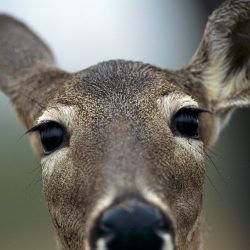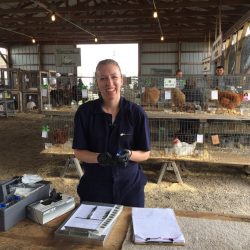By Mckenna Curcio

This summer, I have the pleasure of working with veterinarians on quite a few dairy farms. These farms have varied drastically from a 5,000-head farm with a rotary parlor to a 300-head, completely robotic dairy. But, the one thing that has been the same on every dairy is the commitment the veterinarians have to ensuring that the cows have a high standard of welfare.
When I found out that I would shadow dairy veterinarians, I thought that most of our time would be spent doing pregnancy checks, conducting physicals on sick animals, and maybe even performing a few surgeries, but this wasn’t the case. The majority of our time was spent doing welfare checks. These include walking through the pens and making sure the animals had enough bedding, that they were not overcrowded, that floors were not too slippery, and that the cows had easy access to both food and water. These tasks are relatively simple, so many people do not associate them with veterinary work.

The veterinarians also were responsible to ensure that all employees receive regular welfare training. While in South Dakota, I was able to take part in a training organized by the farm veterinarian. The farm partnered with Merck Animal Health and brought in a veterinarian, who is fluent in English and Spanish. The training centered around low-stress cow handling and working with down cows. The training began with a dairy care video, provided by Merck, and then, there was a hands-on portion. During the hands-on portion, the employees were able to demonstrate what they learned while receiving pointers from both of the veterinarians.
Many of the employees knew the correct way to move a cow or to handle a down animal, but they didn’t really understand the “why.” This shows how the veterinarian is so important to the maintenance of a certain level of animal welfare. Veterinarians understand the intricate science behind what the animal needs and why. They are able to accurately explain things like the flight zone, the point of balance, and differences in depth perception. One of the comments that I distinctly remember is an employee saying that he didn’t think that poking a cow with a pen would feel different to the cow than it would feel to him if he were the one being poked. Having the veterinarian there to explain why that may not be accurate is crucial because it gives that person an insight into how the cow perceives certain stimuli. If workers understand why we interact with animals in the way that we do, they are much more likely to comply with and use the proper welfare protocols.
Ensuring that the proper protocols are followed is extremely important. We want to make sure that vaccinations are being given at the right time and in the correct anatomical location, that antibiotics are being used appropriately, and that certain procedures like euthanasia are being done in a humane manner. When done correctly, we ensure better welfare for the animals and a safer product for consumers. As you can see, a veterinarian’s job is more than just caring for sick animals.



